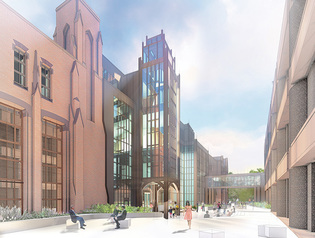 loading
loading
Light & VerityPeabody Museum will get an overhaulMore space for exhibits and school groups—and dinosaurs in updated poses.  Centerbrook Architects and PlannersA new north entrance and terrace is part of renovation and expansion plans for the Peabody Museum. View full imageThe dinosaur skeletons in the Great Hall of the Peabody Museum of Natural History have been holding the same pose for nearly 90 years. But in a year or so, they’ll get a chance to stretch their legs as the museum undergoes a major renovation and expansion. The project will increase the museum’s exhibit space by 50 percent and improve teaching facilities—both for Yale students and for the 30,000 children who visit the museum in school groups every year. Peabody director David Skelly, the Frank R. Oastler Professor of Ecology, says the project entails not only expanding the museum’s size but also its programs. “We’ll be adding staff to help run a bigger, more dynamic museum,” says Skelly, explaining that the new hires will allow for more movement of the collections and a more frequently changing exhibition program. “People expect change. They expect when they come back to the museum they will see something new. And we have the collections to support that expectation.” Edward Bass ’67, who has made several major gifts to Yale, has donated $160 million toward the project—the largest known gift to a museum of natural history, according to the university. Yale won’t release the total cost of the project, but Skelly says they’ve still got another $20 million to raise. The precise schedule for the project has not been determined, though it will likely involve the museum’s closing for at least two years. It will remain open into 2020. At the heart of the redesigned museum will be a new three-story central space that connects the exhibit galleries, improves circulation, and provides “a place to take a break,” in Skelly’s words. A new entrance and terrace on the north side will better connect the museum to Science Hill. And the lower level will feature a new K–12 education center, with classrooms and other facilities to better accommodate school groups and after-school programs. The university community will notice the change, too. Dedicated museum classrooms will allow Yale students and professors to hold classes and interact with the collections, as they do now at the Art Gallery and the Center for British Art. As for those dinosaurs, Skelly says they’re “going on holiday to Canada,” where a leading restoration firm will clean the skeletons and prepare them for reinstallation. “When we reopen, the poses will be much more active and truer to the science that has advanced since they were first mounted in the 1920s,” says Skelly. The rest of the collection will get a similar treatment. New exhibits will be designed with an eye toward greater flexibility. “We want not only to make the exhibitions up to date,” says Skelly, “but to put them on a footing where they can stay up to date.” But a few Peabody favorites, appreciated as much for their artistry as their scientific value, will not be changing. The Age of Reptiles and Age of Mammals murals by Rudolph Zallinger ’42BFA, ’71MFA, and the much-admired third-floor dioramas will be preserved in their current condition.
The comment period has expired.
|
|